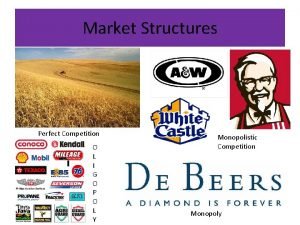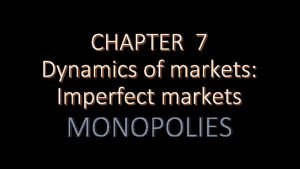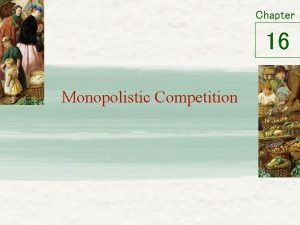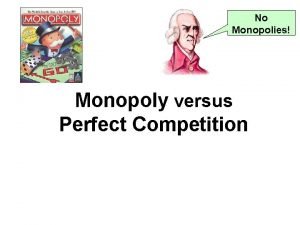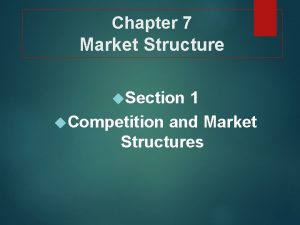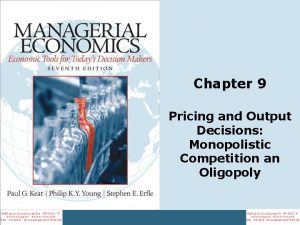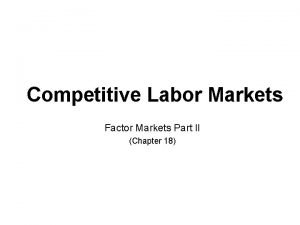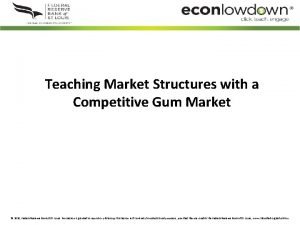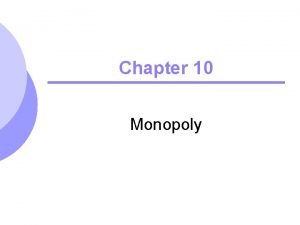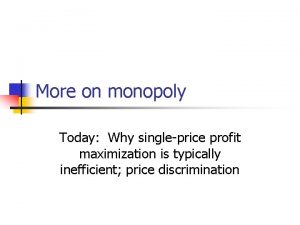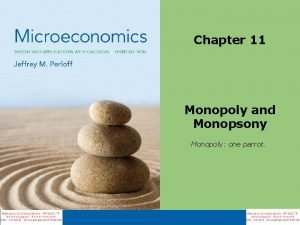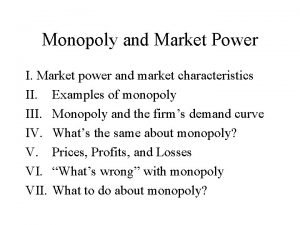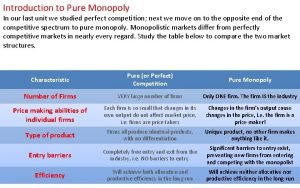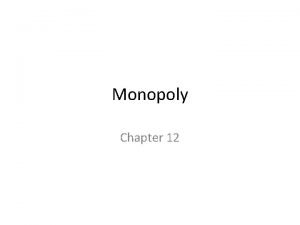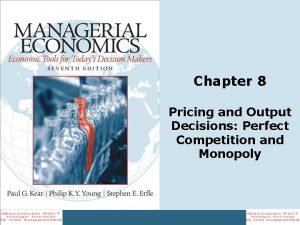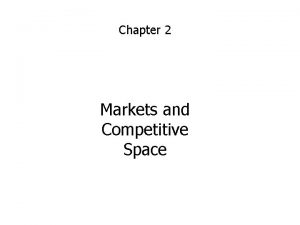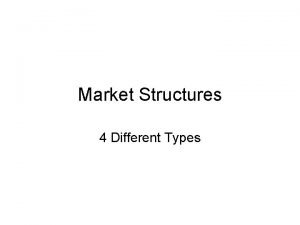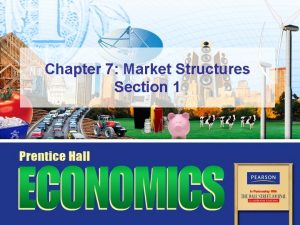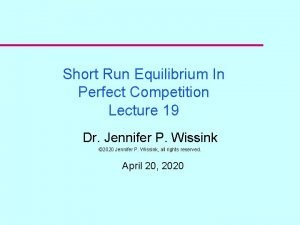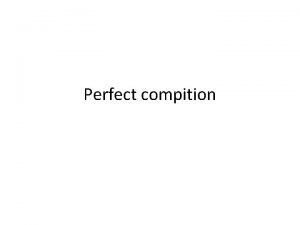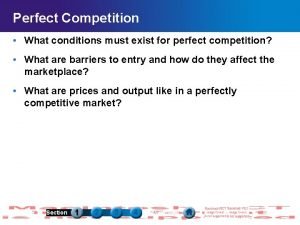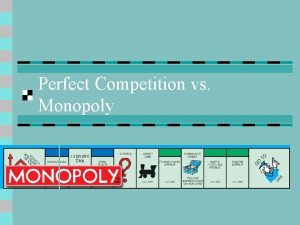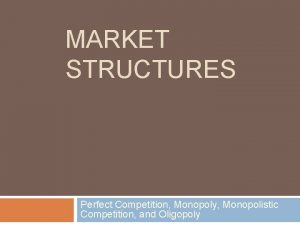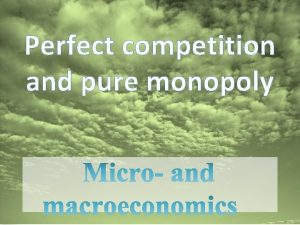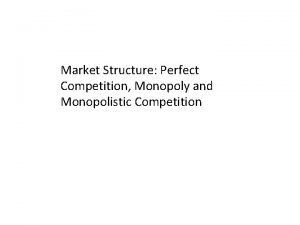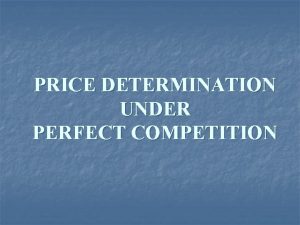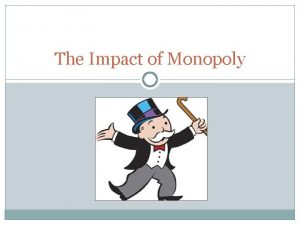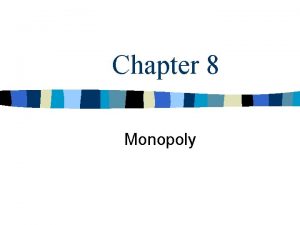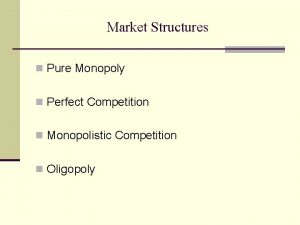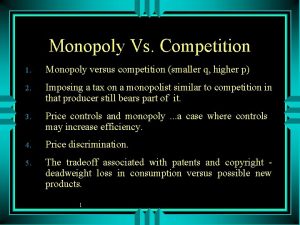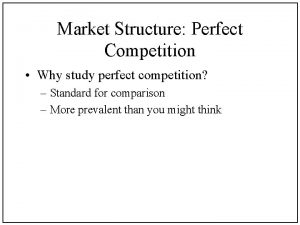Lecture 5 Market Structures Perfect Competition and Monopoly









































- Slides: 41

Lecture 5: Market Structures (Perfect Competition and Monopoly)

Learning Objectives By the end of this session you should be able to: § Identify the criteria used in evaluating the competitiveness of § § markets; Explain the features/ characteristics of for each market structure; Discuss the short-run and long –run equilibrium of the firm; Draw the relevant graphs showing the short-run and long-run profit position of the firm under all the market structure; Explain the Shut-down point of a firm. Unit 5 Copyright © 2017 MDIS. All rights reserved. 2

The Degree of Competition Classifying markets ¡ number of firms ¡ freedom of entry to industry ¡ nature of product ¡ nature of demand curve The four market structures ¡ perfect competition ¡ monopoly ¡ monopolistic competition ¡ oligopoly

Features of the four market structures

Q Under which of the following market structures does a supermarket operate? A. Perfect competition B. Monopolistic competition C. Oligopoly D. Monopoly

Perfect Competition Assumptions ¡ firms are price takers ¡ freedom of entry ¡ identical products ¡ perfect knowledge Short-run equilibrium of the firm ¡ price, output and profit

Short-run equilibrium of industry and firm under perfect competition Firm is a price taker. Price is given by the market. P £ MC S Pe D = AR = MR AR AC D O O Q (millions) (a) Industry AC Qe Q (thousands) (b) Firm

Q Under perfect competition a profit firm will increase output if: A. marginal cost is less than price. B. price exceeds marginal revenue. C. marginal revenue equals average revenue. D. marginal cost exceeds marginal revenue. E. marginal cost equals marginal revenue.

Loss minimising under perfect competition Loss is minimised where MC = MR. P £ S AC P 1 AC MC D 1 = AR 1 = MR 1 D O O Q (millions) (a) Industry Qe Q (thousands) (b) Firm

Q A perfectly competitive firm is producing 1000 units of output per week at a TFC of $1000, a TVC of $1200 and a MC of $1. 00. If the market price is $1. 50, what should the firm do? A. B. C. D. E. Raise its price. Decrease output. Increase output. Maintain output at its present level. Cease production altogether.

Perfect Competition Assumptions ¡ firms are price takers ¡ freedom of entry ¡ identical products ¡ perfect knowledge Short-run equilibrium of the firm ¡ price, output and profit The short-run supply curve of the firm ¡ given by the short-run MC curve

Deriving the short-run supply curve P £ S MC = S a P 1 P 2 b c P 3 D 1 = MR 1 D 2 = MR 2 D 3 = MR 3 D 1 D 3 O Q (millions) (a) Industry D 2 O Q (thousands) (b) Firm

Perfect Competition Long-run equilibrium of the firm ¡ all supernormal profits competed away ¡ LRAC = MC = MR = AR

Long-run equilibrium under perfect competition Profits return Supernormal profits New firms enter to normal P £ S 1 Se LRAC P 1 AR 1 D 1 PL ARL DL D O O Q (millions) (a) Industry QL Q (thousands) (b) Firm

Long-run equilibrium of the firm under perfect competition £ (SR)MC (SR)AC LRAC DL AR = MR LRAC = (SR)MC = MR = AR O Q

Q If all firms (existing and potential entrants) face the same LRAC curves, then the long-run industry supply curve will: D. necessarily be horizontal. slope upwards if there are external economies of scale. only be horizontal if there are constant external costs with respect to industry size. slope downwards if there are external diseconomies of scale. E. slope upwards if there are internal diseconomies of scale. A. B. C.

Perfect Competition Incompatibility of economies of scale with perfect competition Benefits of perfect competition ¡ price equals marginal cost ¡ prices kept low ¡ firms must be efficient to survive

Shut down point / Loss Minimisation § Firm that is not earning positive profits or breaking even is suffering a loss. Firms suffering losses fall into two categories: § those that find it advantageous to shut down operations immediately and bear losses equal to fixed costs, and § those that continue to operate in the short run to minimize their losses. § The most important thing to remember here is that firms cannot exit the industry in the short run. Unit 5 Copyright © 2017 MDIS. All rights reserved. 18

Shut down decision in the SR and LR q It the short-run, it depends on AVC; q If P = AR > AC or TR > TC Firm makes profit q If P = AR = AC or TR = TC Firm breakeven q If P = AR < AC or TR < TC Firm make losses but NO need to shutdown (as P/AR > AVC or TR > TVC, TR can cover an TVC and part of TFC) q If P = AR < AVC or TR < TVC Firm should shut down as TR is not enough to cover even the TVC. q In the long-run, as long as P = AR < AC or TR < TC Firm must shut down as it shows it is inefficient after so long in the operations. Unit 5 Copyright © 2017 MDIS. All rights reserved. 19

Monopoly: Characteristics/ Assumptions § There is only one seller and many buyers. § The product of the monopolist does not have substitute. § The government gives a single firm the exclusive right to produce the good e. g. patents, copyright, government licenses or franchises. § A single firm owns a key resources e. g. De. Beers owns most of the world’s diamond mines § Economies of Scale § Because of the monopoly’s market power, and there are no competitors, it will be able to make supernormal profits in the short-run and long-run. Unit 5 Copyright © 2017 MDIS. All rights reserved. 20

Monopoly: Characteristics/ Assumptions § Monopolist is said to be price setter/maker. § However, monopolist could only control either price or quantity and not both. § Demand curve is downward sloping and relatively inelastic. Unit 5 Copyright © 2017 MDIS. All rights reserved. 21

Monopoly Barriers to entry ¡ economies of scale ¡ economies of scope ¡ product differentiation and brand loyalty ¡ lower costs for an established firm ¡ ownership/control of key factors ¡ ownership/control over outlets ¡ legal protection ¡ mergers and takeovers ¡ aggressive tactics

Q Which one of the following would not be a barrier to firms entering an industry? A. An upward-sloping long-run average cost curve. B. Patents on key processes. C. Substantial economies of scale. D. Large initial capital costs. E. The threat of takeover by the existing firm(s).

Monopoly: P = AR/P/D > MR Quantity Price TR MR 0 10 0 - 1 9 9 9 2 8 16 7 3 7 21 5 4 6 24 3 5 5 25 1 6 4 24 -1 7 3 21 -3 Unit 5 Copyright © 2017 MDIS. All rights reserved.

Monopoly The monopolist’s demand curve ¡ downward ¡ MR sloping below AR Equilibrium price and output ¡ Equilibrium output, where MC = MR

Profit maximising under monopoly £ MC Profit maximised at output of Qm (where MC = MR) MR O Qm Q

Monopoly The monopolist’s demand curve ¡ downward sloping ¡ MR below AR Equilibrium price and output ¡ Equilibrium output, where MC = MR ¡ Equilibrium price, found from demand curve

Profit maximising under monopoly £ MC AC AR MR O Qm Q

Monopoly The monopolist’s demand curve ¡ downward sloping ¡ MR below AR Equilibrium price and output ¡ Equilibrium output, where MC = MR ¡ Equilibrium price, found from demand curve Profit ¡ Measuring profit

Profit maximising under monopoly £ MC Total profit AC AR MR O Qm Q

Q The diagram shows a monopoly. Which letter gives the profitmaximising price? A. B. C. D. E.

Monopoly The monopolist’s demand curve ¡ downward ¡ MR sloping below AR Equilibrium price and output ¡ Equilibrium output, where MC = MR ¡ Equilibrium price, found from demand curve Profit ¡ Measuring profit ¡ Supernormal profit can persist in long run

Monopoly Disadvantages of monopoly ¡ high prices / low output: short run

Equilibrium of industry under perfect competition and monopoly: with the same MC curve £ MC Monopoly P 1 AR = D MR O Q 1 Q

Equilibrium of industry under perfect competition and monopoly: with the same MC curve £ MC ( = supply under perfect competition) Comparison with Perfect competition P 1 P 2 AR = D MR O Q 1 Q 2 Q

Monopoly Disadvantages of monopoly ¡ high prices / low output: short run ¡ high prices / low output: long run ¡ lack of incentive to innovate ¡ X-inefficiency Advantages of monopoly ¡ economies of scale

Equilibrium of industry under perfect competition and monopoly: with different MC curves £ MCmonopoly P 1 AR = D MR O Q 1 Q

Equilibrium of industry under perfect competition and monopoly: with different MC curves MC ( = supply)perfect competition £ MCmonopoly P 2 P 1 Higher price (P 2) under perfect competition x AR = D MR O Q 2 Q 1 Q

Equilibrium of industry under perfect competition and monopoly: with different MC curves MC ( = supply)perfect competition £ MCmonopoly P 2 P 1 Monopoly could produce at even lower price by producing where MC = P. x P 3 AR = D MR O Q 2 Q 1 Q 3 Q

Monopoly Disadvantages of monopoly ¡ high prices / low output: short run ¡ high prices / low output: long run ¡ lack of incentive to innovate ¡ X-inefficiency Advantages of monopoly ¡ economies of scale ¡ profits can be used for investment ¡ high profits encourage risk taking

The end… (kind of!)
 Difference between monopoly and perfect competition
Difference between monopoly and perfect competition Difference between perfect competition and monopoly
Difference between perfect competition and monopoly Difference between perfect competition and monopoly
Difference between perfect competition and monopoly P = mc
P = mc Difference between perfect competition and monopoly
Difference between perfect competition and monopoly Monopoly characteristics
Monopoly characteristics Chapter 7 section 1 competition and market structures
Chapter 7 section 1 competition and market structures Perfect competition vs monopolistic competition
Perfect competition vs monopolistic competition Competition refers to
Competition refers to Monopolistic competition pictures
Monopolistic competition pictures Example of pure competition
Example of pure competition Pure competition and monopoly _____
Pure competition and monopoly _____ Factor market perfect competition
Factor market perfect competition Example of pure competition
Example of pure competition Teaching market structures with a competitive gum market
Teaching market structures with a competitive gum market Market segmentation lesson
Market segmentation lesson Market structures venn diagram
Market structures venn diagram 01:640:244 lecture notes - lecture 15: plat, idah, farad
01:640:244 lecture notes - lecture 15: plat, idah, farad Market leader challenger follower nicher examples
Market leader challenger follower nicher examples Homologous structures
Homologous structures Cortar present perfect
Cortar present perfect Monopoly example
Monopoly example What is a single price monopoly
What is a single price monopoly Monopoly market examples
Monopoly market examples Characteristic of monopoly
Characteristic of monopoly Diagram of monopoly
Diagram of monopoly Characteristics of monopoly market
Characteristics of monopoly market Monopoly in economics
Monopoly in economics Perfectly price discriminating monopoly
Perfectly price discriminating monopoly Short run equilibrium under perfect competition
Short run equilibrium under perfect competition Pricing and output decisions in perfect competition
Pricing and output decisions in perfect competition Long run profit in perfect competition
Long run profit in perfect competition Makisha floss market structure
Makisha floss market structure Pure competition market
Pure competition market Different market structures
Different market structures How does deregulation encourage competition in a market
How does deregulation encourage competition in a market Market structures graphic organizer
Market structures graphic organizer Perfect competition side by side graphs
Perfect competition side by side graphs Short run market supply curve
Short run market supply curve What is compition
What is compition Monopoly conditions
Monopoly conditions Long run market supply curve
Long run market supply curve
